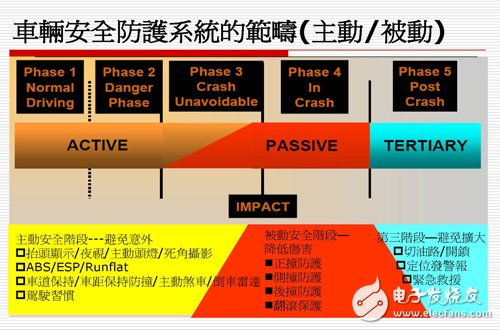Adding gas detection function, the car passive safety design is more comprehensive
Core Tip : Gas detection will be an important feature of automotive passive safety systems. Excessive concentrations of carbon dioxide or carbon monoxide in the car can cause discomfort in driving and passengers, and even cause traffic accidents. Therefore, the active detection of harmful gas concentrations through gas sensors, combined with GPS and GSM communication technology, has become an important trend in passive safety design of automobiles.
According to statistics from the Ministry of Communications, fatigue driving is one of the main causes of traffic accidents. Due to the hot and hot weather patterns in Taiwan in the summer and the poor air quality, many drivers are accustomed to using the in-vehicle recirculating air conditioning system for a long time. However, in the confined space where the compartment is small, the carbon dioxide produced by the body's metabolism is quickly accumulated in the compartment, which will make the air inside the vehicle dirty. When the concentration of carbon dioxide reaches 0.5%, people will have headaches, dizziness and other discomfort, resulting in physical exhaustion and inattention without knowing. Many fatigue driving situations will occur, resulting in accidents of traffic accidents and frequent traffic. A big worry about security.
In addition, if the engine of the automobile is incompletely burned, the generated exhaust gas contains toxic gas such as carbon monoxide, which may cause toxic gas to flow back into the vehicle compartment through the vent hole due to aging of the automobile vent hole. Since carbon monoxide is a colorless, odorless gas, the symptoms after poisoning are not easily detected, and the driver will unconsciously lose consciousness and become an invisible killer hidden in the closed space of the car, which is safe for the driver and social resources. Causes great threats.
The device is related to the passive safety design of the car, in particular to a device for preventing the stun or fatigue of the driver of the car, which can detect the concentration of a specific gas inside the vehicle, and when the concentration is greater than the set warning value, it causes a coma to the human body. Or when it is tired, it can automatically open the window; when its concentration is greater than the set threshold, it can automatically issue the car address and distress signal, so as to reduce the concentration of specific gas inside the car in time, to avoid the driver being at high for a long time. The concentration of specific gas in the confined space, and improve the efficiency of subsequent rescue, effectively reduce the casualties of the car, to avoid the subsequent increase in casualties.
Strengthen the safety and protection of the car's passive safety system into a wind
There are two main reasons for the in-depth discussion of this device: First, when the driver is in a high concentration of carbon monoxide or carbon dioxide confined space, often unconsciously poisoning and causing drowsiness, if the window glass cannot automatically detect the drop, let the outside When the fresh air is introduced to reduce the concentration of toxic gases inside the car, it will still pose a great threat to the driver's life when exposed for a long time. Secondly, when the driver has been poisoned and slumbered, he has unconsciously and can tell the car correctly. The location, if the rescuers can not know the location of the car in a short period of time, and provide follow-up rescue operations, it is still impossible to avoid the deterioration or even increase of the casualties (such as the exposure of carbon monoxide in the environment of 1,600ppm, will die within 2 hours), prevention Car drivers are unconscious or tired, further avoiding fatigue driving, preventing regrets and fighting for rescue time, another major motivation for the device.
Figure 1 is a schematic diagram showing a vehicle (active/passive) safety protection system for a vehicle traveling on a general road. As for the general vehicle road traffic safety protection system, it can be divided into three stages. The first stage is the active safety stage, the main purpose is to avoid accidents in the car accident; the second stage is the passive safety stage, whose main purpose is to reduce accidental injuries in traffic accidents; The main purpose of the third stage is to avoid the expansion of subsequent injuries.

Figure 1 Category of vehicle safety protection system
According to the current development trend of the world's advanced security system technology, the focus has gradually evolved from the past to the passive and even the third stage. Commonly developed active safety technologies include anti-lock braking system (ABS) and electronic body stabilization system ( ESP), reversing radar, active headlights, head-up display, night vision, distance keeping and collision avoidance.
however. Due to traffic accidents, it has not been completely avoided. Especially in the case of a powerful car accident, in order to reduce the casualties of the people in the car, it has been developed towards passive safety to reduce injuries. Commonly developed technologies include seat belts, safety airbags, and collision protection. Side impact protection, rear collision protection and tumbling protection; some advanced cars even attach importance to the third stage safety protection to avoid injury expansion. The current development technology has automatic cut off oil circuit, automatic opening central locking, positioning alarm and emergency rescue. And other technologies.
According to the data, the electronic safety control and safety system of advanced safety vehicles accounted for 40% of the total vehicle cost in 2010. It is obvious that in the human rights era where personal life safety is gradually valued, the design safety of the second stage passive safety system and the third stage emergency rescue. It is highlighted that the above-mentioned safety technologies are all limited to the passive safety protection system of the automobile driving in the ordinary road accident.
Preventive driving, carbon monoxide poisoning, passive safety protection system, evolution
The Republic of China Patent No. M405617 discloses a "vehicle gas detecting device" which is mainly composed of a gas detecting unit, a control unit and an alarm unit. The gas detecting unit comprises a plurality of gas detecting units. Sensory components inside and outside the vehicle. The sensing component measures the concentration of carbon monoxide in the environment and converts it into a digital signal for transmission to the gas detecting unit.
When the gas detecting unit determines that the carbon monoxide concentration is too high, it sends a signal to the control unit, thereby causing the alarm unit to act to remind the user, or to further turn off the power to force the vehicle to be turned off to protect the life safety of the person. Driver's warning and safety protection, but it is passive and passive. According to the EPD and the Fire Services Department, a small amount of carbon monoxide will cause people to become unconscious and lose consciousness. The alarm sound has no warning effect on the stunned driver. The forced shutdown of the power supply has no significant effect on the concentration of carbon monoxide in the closed compartment. Reduced.
In addition, the gas detection unit cannot locate the parking place of the stunned driver, and immediately sends out a distress signal to the outside, resulting in the loss of most of the subsequent rescue opportunities, and the driver's safety and life cannot be protected. Therefore, in order to reduce the driver's casualties and avoid the expansion of subsequent casualties, the most important treatment should be to immediately open the window to reduce the concentration of carbon monoxide inside the vehicle. Secondly, the parking location will be addressed and a distress signal will be automatically issued immediately.
In addition, referring to the Republic of China Patent No. M295137, it discloses a "ozone machine with detection of harmful gases and an alarm capable", comprising a casing, an ozone generator disposed inside the casing, and being disposed at a circuit substrate inside the casing, at least one detector connected to the circuit substrate, and at least one alarm device; wherein the ozone generator can be controlled to output ozone, and the detector can detect gas, high concentration carbon monoxide or carbon dioxide When the detector detects harmful gas such as gas leakage, high concentration of carbon monoxide or carbon dioxide, it will output an electronic signal to the circuit substrate, thereby causing the ozone generator to generate ozone to oxidize and decompose harmful gases, and The alarm device will beep or flash to inform the user of the serious hazard caused by the gas leakage or the high concentration of carbon monoxide produced by the charcoal.
However, if the sensor is applied to prevent car driver from carbon monoxide poisoning, it has no positive and effective effect. For the same reason, the concentration of carbon monoxide will cause the person to be unconscious and lose consciousness. The alarm device is not too big for the stunned driver. The warning function, plus no follow-up to address the parking place and automatically send out a distress signal, can not protect the safety and life of the driver.
In order to avoid the above-mentioned prior art gas detection alarm system, the "carbon monoxide concentration" inside the vehicle compartment cannot be significantly reduced; in addition, the vehicle address and distress signal can not be automatically issued at the first time, resulting in the loss of the rescue time. It is recognized that the current traffic accidents are not limited to accidents that are commonly found on roads. Instead, the specific gas concentration is abnormal and the driver is unconscious or tired. The number of accidents and accidents caused by accidents is much higher than that of ordinary accidents. (Because the driver often slumbers and suffocates in unconscious conditions, when he is discovered, he has already returned to the sky), so the passive safety protection system that prevents car drivers from carbon monoxide poisoning and rescue should be further emphasized, and the tradition is limited to cars. Passive safety protection systems for general road accidents should be broadly defined and designed to cause casualties caused by specific gas concentrations in motorists.
- Perfect for all vehicles that use a standard US EU license plate,the angle of camera can be adjusted 45 degrees by loose screw.
- [Equipped with 4 6 8 Night Vision Infrared LEDs optional]extends visibility in low light condition, ensuring complete safety even at full darkness.
- [100% Waterproof & Low power consumption]Waterproof IP68 Rating and Consume less than 40 mA.Ensure it have a long time service life.
- [ The total length of the wire is 32 ft] It is perfect for most cars and SUV RV PICKUP,Easy to install
-
[Reliable & Friendly Customer Service] Ready to respond within a 24 hour time frame. 30-Day Money Back Guarantee, 12 Month Replacement Warranty and Lifetime Support Guarantee

License Plate Reverse Camera,License Frame Backup Camera,Wired License Frame Backup Camera,Led License Frame Backup Camera
Shenzhen Sunveytech Co.,LTD , https://www.sunveytech.com